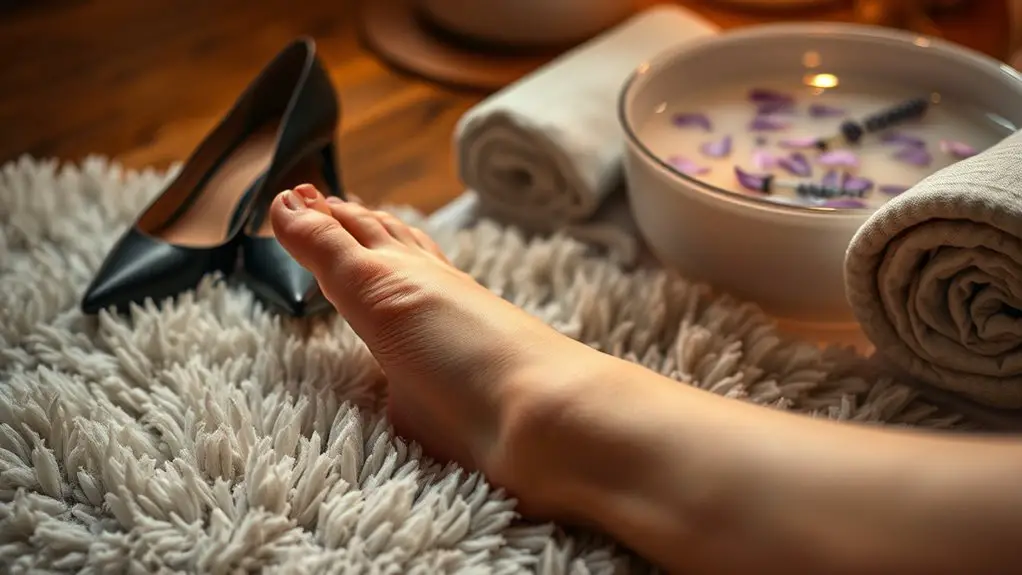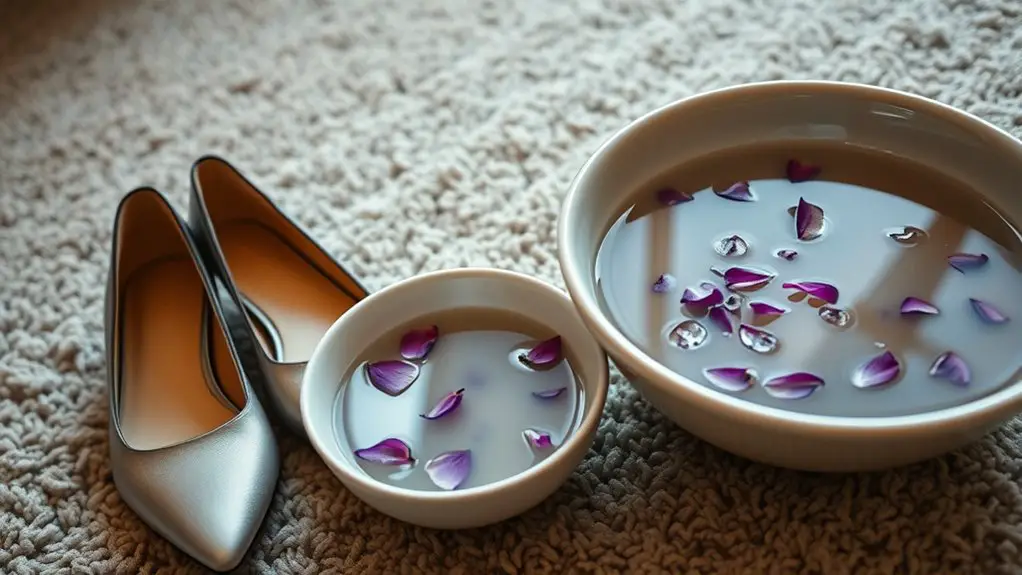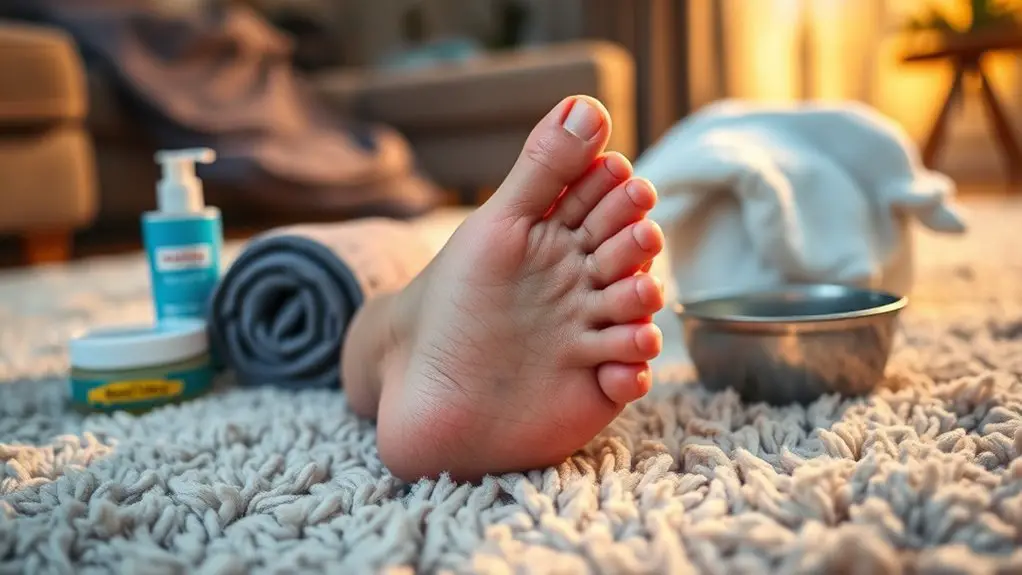If you’re experiencing heel pain after a long day, it’s often due to factors like plantar fasciitis or improper footwear. To soothe your feet, practice effective stretching techniques for your calves and plantar fascia. Choosing supportive shoes with proper cushioning can alleviate strain. Additionally, consider foot soaks or massages to enhance comfort and circulation. If discomfort persists or worsens, consulting a healthcare professional is recommended. Continue exploring strategies to better manage your heel pain and improve foot health.
Understanding Heel Pain: Common Causes

Heel pain is a common complaint that can stem from various underlying issues, and understanding these causes is essential for effective treatment. One of the primary culprits is plantar fasciitis, characterized by inflammation of the plantar fascia, a thick band of tissue running across the bottom of your foot. Common plantar fasciitis symptoms include sharp pain near the heel, especially with the first steps in the morning or after prolonged sitting. Additionally, chronic strain on the plantar fascia can lead to heel spur formation, where calcium deposits develop on the heel bone, causing further discomfort. Factors such as high-impact activities, improper footwear, and excessive weight can exacerbate these conditions. Recognizing these signs and understanding the relationship between plantar fasciitis and heel spur formation can guide you in seeking appropriate medical advice and implementing necessary lifestyle changes to alleviate your heel pain.
Effective Stretching Techniques for Relief
How can effective stretching techniques alleviate heel pain and promote recovery? Incorporating both dynamic and static stretches into your routine can provide significant relief. Dynamic stretches, such as ankle circles and toe raises, enhance blood flow and flexibility before activities. These movements prepare your feet and calves for the demands of the day, reducing the likelihood of pain.
On the other hand, static stretches, like the calf stretch against a wall or the seated toe stretch, should be performed after your activities. Holding these stretches for 15-30 seconds helps lengthen the muscles and tissues, alleviating tension in the heel area.
Aim to integrate these stretching techniques into your daily regimen, focusing on both the plantar fascia and calf muscles. By actively engaging in these practices, you can effectively reduce heel pain and enhance your overall foot health, promoting a quicker recovery after long days on your feet.
Choosing the Right Footwear

Finding the right footwear can make a significant difference in your overall foot health and comfort. Selecting shoes that provide adequate arch support and are made from appropriate footwear materials is essential. Here are some key factors to take into account when choosing your footwear:
- Arch Support: Confirm your shoes have proper arch support to distribute weight evenly and reduce strain on your feet.
- Footwear Materials: Opt for breathable materials like mesh or leather, which can help in moisture management and overall comfort.
- Cushioning: Look for shoes with adequate cushioning to absorb impact and minimize discomfort during prolonged wear.
- Fit and Size: Always choose the right size; shoes that are too tight or too loose can exacerbate foot pain.
Foot Soaks and Massage for Relaxation
After a long day on your feet, a soothing foot soak combined with a gentle massage can greatly alleviate discomfort and promote relaxation. Start by preparing an herbal soak using warm water infused with relaxing herbs like lavender or chamomile. These herbal soaks not only ease tension but also provide anti-inflammatory benefits. Soak your feet for about 15-20 minutes to soften the skin and enhance circulation.
Following the soak, apply essential oils such as peppermint or eucalyptus for their cooling and invigorating properties. Dilute a few drops in a carrier oil, then gently massage your feet, focusing on the arches and heels. This combination of warmth from the soak and targeted pressure from the massage helps reduce swelling and pain. Regularly incorporating these practices into your routine can greatly improve your foot health and overall well-being, making those long days more bearable.
When to Seek Professional Help

Foot care routines, including soaks and massages, can greatly enhance comfort, but there are situations where self-care isn’t enough. If you’re experiencing persistent heel pain, consider seeking professional help. Early intervention can prevent worsening chronic conditions. Here are some indicators it’s time to consult a healthcare provider:
- Pain lasting more than a few days despite self-care.
- Swelling or redness around the heel or foot.
- Difficulty walking, standing, or bearing weight on the affected foot.
- A noticeable change in foot shape or structure.
Ignoring these symptoms can lead to more severe issues, so don’t hesitate to seek guidance. A professional can provide a proper diagnosis and treatment plan tailored to your needs, ensuring you regain comfort and mobility effectively. Remember, timely intervention can make a significant difference in your recovery journey.
Frequently Asked Questions
Can Diet Affect Heel Pain and Foot Health?
Yes, diet can markedly affect heel pain and foot health. Incorporating anti-inflammatory foods and nutritional supplements may help reduce inflammation, supporting overall foot health and potentially alleviating discomfort related to heel pain.
What Are Some Effective Home Remedies for Heel Pain?
For heel pain, ironically, just sitting around won’t help. Try ice therapy to reduce inflammation and give yourself a foot massage to improve circulation. Both methods can effectively alleviate discomfort and promote healing in your feet.
How Can I Prevent Heel Pain in the Future?
To prevent heel pain in the future, prioritize proper footwear that provides adequate support. Additionally, incorporate stretching routines targeting your calves and Achilles tendon to enhance flexibility and reduce strain on your heels during daily activities.
Are There Specific Exercises to Avoid With Heel Pain?
If you’re experiencing heel pain, it’s best to avoid high-impact exercises and certain stretches that exacerbate discomfort. Additionally, make certain your footwear choices provide adequate support to minimize stress on your heels during activities.
Does Weight Gain Influence Heel Pain Severity?
Yes, weight gain can influence heel pain severity. Increased weight alters weight distribution and amplifies impact forces on your feet, leading to heightened discomfort and potential injury. Managing weight may help alleviate these symptoms over time.



